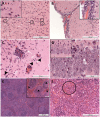A Susceptible Mouse Model for Zika Virus Infection
- PMID: 27149521
- PMCID: PMC4858159
- DOI: 10.1371/journal.pntd.0004658
A Susceptible Mouse Model for Zika Virus Infection
Abstract
Zika virus (ZIKV) is a mosquito-borne pathogen which has recently spread beyond Africa and into Pacific and South American regions. Despite first being detected in 1947, very little information is known about the virus, and its spread has been associated with increases in Guillain-Barre syndrome and microcephaly. There are currently no known vaccines or antivirals against ZIKV infection. Progress in assessing interventions will require the development of animal models to test efficacies; however, there are only limited reports on in vivo studies. The only susceptible murine models have involved intracerebral inoculations or juvenile animals, which do not replicate natural infection. Our report has studied the effect of ZIKV infection in type-I interferon receptor deficient (A129) mice and the parent strain (129Sv/Ev) after subcutaneous challenge in the lower leg to mimic a mosquito bite. A129 mice developed severe symptoms with widespread viral RNA detection in the blood, brain, spleen, liver and ovaries. Histological changes were also striking in these animals. 129Sv/Ev mice developed no clinical symptoms or histological changes, despite viral RNA being detectable in the blood, spleen and ovaries, albeit at lower levels than those seen in A129 mice. Our results identify A129 mice as being highly susceptible to ZIKV and thus A129 mice represent a suitable, and urgently required, small animal model for the testing of vaccines and antivirals.
Conflict of interest statement
The authors have declared that no competing interests exist.
Figures



Comment in
-
Zika Virus: A New Animal Model for an Arbovirus.PLoS Negl Trop Dis. 2016 May 5;10(5):e0004702. doi: 10.1371/journal.pntd.0004702. eCollection 2016 May. PLoS Negl Trop Dis. 2016. PMID: 27149628 Free PMC article. No abstract available.
Similar articles
-
An Alanine-to-Valine Substitution in the Residue 175 of Zika Virus NS2A Protein Affects Viral RNA Synthesis and Attenuates the Virus In Vivo.Viruses. 2018 Oct 7;10(10):547. doi: 10.3390/v10100547. Viruses. 2018. PMID: 30301244 Free PMC article.
-
Evaluating Zika Virus Pathogenesis in Immunocompromised Mice.Methods Mol Biol. 2020;2142:23-40. doi: 10.1007/978-1-0716-0581-3_3. Methods Mol Biol. 2020. PMID: 32367356
-
Antiviral CD8 T cells induce Zika-virus-associated paralysis in mice.Nat Microbiol. 2018 Feb;3(2):141-147. doi: 10.1038/s41564-017-0060-z. Epub 2017 Nov 20. Nat Microbiol. 2018. PMID: 29158604 Free PMC article.
-
Recent Advances in Animal Models of Zika Virus Infection.Virol Sin. 2018 Apr;33(2):125-130. doi: 10.1007/s12250-018-0007-4. Epub 2018 Mar 14. Virol Sin. 2018. PMID: 29541942 Free PMC article. Review.
-
Zika infection and the development of neurological defects.Cell Microbiol. 2017 Jun;19(6). doi: 10.1111/cmi.12744. Epub 2017 May 3. Cell Microbiol. 2017. PMID: 28370966 Review.
Cited by
-
RT-qPCR Analysis of Inflammatory & Apoptotic Factors-Related Gene Expression in ZIKV-Infected IFNAR1-/- Mice.Curr Microbiol. 2024 Oct 21;81(12):418. doi: 10.1007/s00284-024-03943-y. Curr Microbiol. 2024. PMID: 39432111
-
Suitable Mouse Model to Study Dynamics of West Nile Virus Infection in Culex quinquefasciatus Mosquitoes.Trop Med Infect Dis. 2024 Sep 2;9(9):201. doi: 10.3390/tropicalmed9090201. Trop Med Infect Dis. 2024. PMID: 39330890 Free PMC article.
-
Orthoflaviviral Inhibitors in Clinical Trials, Preclinical In Vivo Efficacy Targeting NS2B-NS3 and Cellular Antiviral Activity via Competitive Protease Inhibition.Molecules. 2024 Aug 27;29(17):4047. doi: 10.3390/molecules29174047. Molecules. 2024. PMID: 39274895 Free PMC article. Review.
-
Emerging and reemerging infectious diseases: global trends and new strategies for their prevention and control.Signal Transduct Target Ther. 2024 Sep 11;9(1):223. doi: 10.1038/s41392-024-01917-x. Signal Transduct Target Ther. 2024. PMID: 39256346 Free PMC article. Review.
-
The inoculum dose of Zika virus can affect the viral replication dynamics, cytokine responses and survival rate in immunocompromised AG129 mice.Mol Biomed. 2024 Aug 3;5(1):30. doi: 10.1186/s43556-024-00195-x. Mol Biomed. 2024. PMID: 39095588 Free PMC article.
References
-
- Dick G.W., Kitchen S.F., and Haddow A.J., Zika virus. I. Isolations and serological specificity. Trans R Soc Trop Med Hyg, 1952. 46(5): p. 509–20. - PubMed
-
- Darwish M.A., et al., A sero-epidemiological survey for certain arboviruses (Togaviridae) in Pakistan. Trans R Soc Trop Med Hyg, 1983. 77(4): p. 442–5. - PubMed
-
- Marchette N.J., Garcia R., and Rudnick A., Isolation of Zika virus from Aedes aegypti mosquitoes in Malaysia. Am J Trop Med Hyg, 1969. 18(3): p. 411–5. - PubMed
-
- Olson J.G., et al., Zika virus, a cause of fever in Central Java, Indonesia. Trans R Soc Trop Med Hyg, 1981. 75(3): p. 389–93. - PubMed
Publication types
MeSH terms
Substances
Grants and funding
LinkOut - more resources
Full Text Sources
Other Literature Sources
Medical
Molecular Biology Databases

